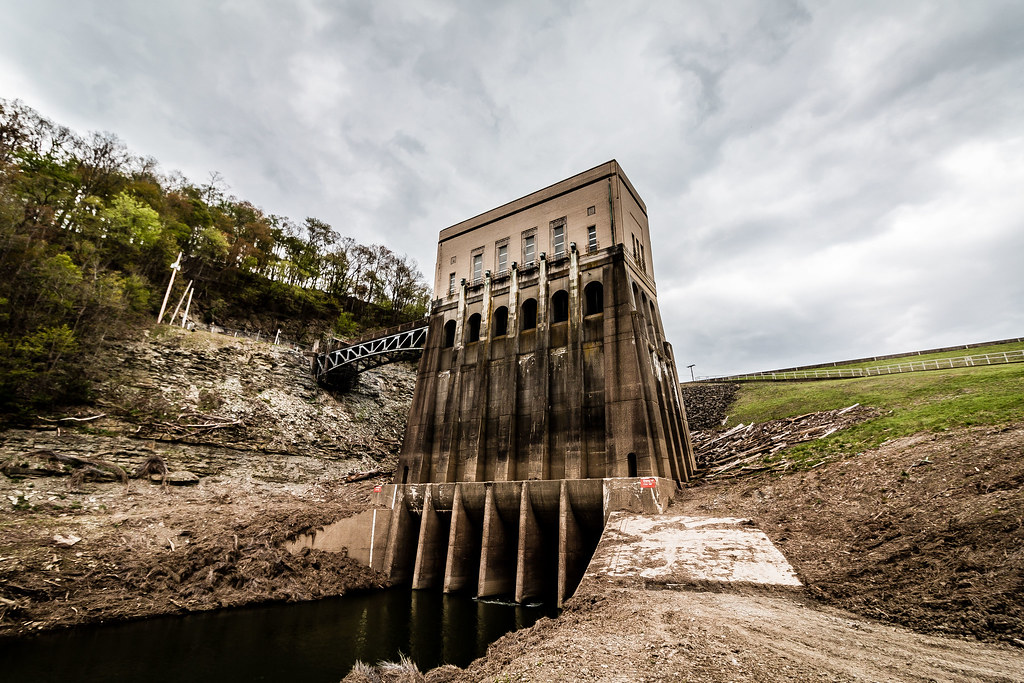Dry dams are catchment areas that have been designed to hold excess water in times of flooding and allow water to move freely in normal conditions. This is a short term flood mitigation solution that stores water for approximately 24 to 48 hours before slowly releasing the water to prevent downstream flooding. There are no permanent areas for holding water, which is why these structures are called “dry dams” [1].This form of flood mitigation is useful for smaller, more frequent floods that can erode river banks [2].
Dry dams are designed to retain excess flood water for a short-period of time (24-48 hours). Once the time has lapsed the water is then released at a slow and controlled rate through gates located at the outlet. While dry dams on their own would only be capable of addressing smaller floods, this mitigation method combined with other strategies, such as larger reservoir dams, have the potential to mitigate for larger floods such as those seen in 2013 [3].
Dry dams are not currently built in Alberta, however, a Government of Alberta feasibility study is currently underway to determine whether or not this form of flood mitigation could be used.
This following is a dry-dam located in Ohio.

Construction costs to build a dry dam vary depending on size and landscaping requirements, therefore, it is difficult to discern a specific cost. Also, regular maintenance and upgrading costs are needed which, range from 3 to 5% of the original construction costs and must occur every 10 to 20 years. Maintenance requires unclogging sediment and removing overgrowth [4]. For example, after major flooding in Miami in 1913 a system of five dry dams was built to retain flood waters and prevent future damage. This original system cost $30.36 million to construct. In today’s dollars, this system of dry dams would cost $912 million to replace [5].
Construction start and completion dates depend on how many dry dams are being built and their size. For example, the five dry dams constructed on the Miami River took five years to construct [6].
Dry dams are considered a long-term, permanent flood mitigation strategy. Maintenance is required especially after the event of a flood or storm surge to remove debris and sediment deposits.
Risks associated with the construction and use of dry dams include; structural and hydraulic design, sediment management, water quality, clogging problems due to debris, and ecosystem and land-use issues in the surrounding area [7]. Lastly, ongoing costs for maintenance and upgrading can be significant.
Given the design of dry dams as a short-term retention area for excess water, this inundation can lead to the loss of vegetation, forests and natural areas. To prevent adverse impacts to the local environment and biodiversity, dry dams should be built to accommodate both regular and rare floods, which require large storage capacity [8]. The local watershed can also be impacted due to interruption of the sediment transport process. River flows carry sediment downstream for aquatic species and erosion prevention. Interrupting this process can cause turbidity issues downstream and soil erosion on riverbanks [9].
Dry dam infrastructure cannot mitigate for drought given the design of the infrastructure to hold excess water and manage flooding.
We provide Canadian educational resources on water practices to promote conservation and sustainability. Our team crafts current and relevant content, while encouraging feedback and engagement.
The Canada WaterPortal is a registered charity, #807121876RR0001
We recognize and respect the sovereignty of the Indigenous Peoples and communities on whose land our work takes place.
© 2025 All Rights Reserved.